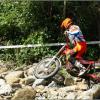-
Posts
173 -
Joined
-
Last visited
-
It's a 309 from 1991, they were released at the same time as the first K-Roo with the same colour scheme and suspension as the K-Roo. I think the site that fourex gave has got the year wrong, this is another site that has plenty of info https://www.fanticmotor.asso.fr/r02.htm I had one from new and still have it now. The USD forks were very similar to what everyone was using at the time and were as good as anything around when new. Considering they are nearly 30 years old they are still a very capable machine and the engines are great. Like any old bike spares can be a problem but nothing that can't be overcome if you really want to. At some point I wouldn't mind getting another one and upgrading it but that's a project for the future!
-
I’ve got a handbook, comes with the road race license, but in usual ACU style it is less than clear. Based on the comments so far and that they don’t seem to be standard on newer bikes I guess I’m ok as I am. My new local club has an event on this weekend and a club meet next week, I’ll get myself along to one or both of those to have a chat.
-
Having not ridden in an ACU trial for 10 plus years I just want to check if there’s anything that has become compulsory in recent years? I’ve read the appropriate sections of the handbook and all I can find is that output sprockets must be covered, chainguards must be as manufactured and about rear sprocket guards in the general bike description section but nothing specific about them in the trials section. Are sharks fin (as there called in road racing) rear sprocket/chain guards required for trials?
-
The 307 and 309 are virtually identical. As has been mentioned the exhaust is different the front forks have different dampers and it has a smaller diameter rear disc although it uses the same calliper so the pads are too big and you get a step at the top of the pads as they wear. Two other things to watch out for is the rear subframe can get worn through where your boots rub against I put some thick rubber tube over it to protect it and the lightweight swing arm spindle is very delicate! It was brought out the same year as the first KRoo and shares the same colour scheme. Love my one had it from new. Still think the engine is better the the KRoo was.
-
It's not a TSS, it's a Montjuic 360 based 24 hour racer. Hence the lights and big tank.
-
I'd love to see a picture of the other side of the Morini. There's no foot controls on the side we can see, must be a modern bike rider who likes a right foot rear brake.
-
So am I. The racer is my dad's I raced it for about 20 seasons. Last time I rode it I finished 3rd in the 2015 Classic Junior TT. I also have a Moto Guzzi 250 TS as a different road bike!
-
The 350 was definitely available in 65 and possible 64. The 250 version which is basically the same was available from 62 so the bikes themselves are old enough. It's only a case of if you have to prove it one was used pre-65! If he built it in 71 I doubt it was from a new machine as the "widecase" version of the bike was released in 69. This was taken all the way to 450cc but is significantly heavier and quite a bit wider than the narrowcase model he used.
-
I agree would be more than happy with either of them. I’ve always like things that are a bit different and a Ducati for pre-65 certainly fits different! For reference the Peter Gaunt one is probably a 350 Sebring. Same as the pictures!
-
Had a closer look at the picture if this one. The seat rails have been modified to lower the seat and move the top mounting for the rear units. The mounting point on the swing arm has also been modified slightly. The lower rails of the rear triangle have also been shortened seeming the allow space for the exhaust. Not sure that is the best idea as I would of thought it would exaggerate what is the naturally weakest area of the Ducati frame.
-
I would have thought the most likely option is the 160 Monza Junior. The cranckcases were different on the 250 version. Of all the Ducati singles the 160 is probably the best option for a trials bike due to the compact size and potential power to weight ratio.
-
It's a 160 not a 250. Of all the Ducati's I've always though that the 160 would make the best pre-65 trials bike. If I could pick up a donor bike for sensible money it's what I would build just to be different! The frame looks fairly standard but it's hard to tell if the headstock angles have been modified from the picture.
-
I agree to a point but when you have a bike that would have had solid round discs originally I would rather have round discs with slots cut in it than a full wavy disc. I'd most like something like a Beta Evo disc in pattern.
-
I can see the logic that a wavy disc will help clear mud etc from the disc/pad surface and can see the logic that it would give a bit more bite to the brake both of which seem to be very desirable for modern trials. They certainly seem to work on my mountain bike. Old trials fanatic can I ask where your getting the discs from and how much they are charging? I've been looking for some discs for my 309 I've found a couple of companies that make them but no uk resellers for them.
-

Toni Bou Sidelined with 3 Broken Vertebrae
smokey125 replied to cackallacky's topic in World Championship Chat
Once it's stabilised enough to not cause him any discomfort whilst riding it won't effect him in any way. The thing I find interesting is that over the last 20 years it seems that every form of motorcycle sport has introduced multiple safety improvements either to the bikes themselves or to the riders kit, yet nothing seems to have changed in trials. Not entirely sure what to suggest but would of thought some form of back protection would be easy enough to introduce even if only for the top levels of the sport.






